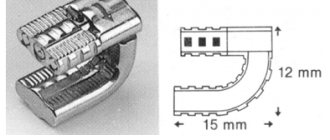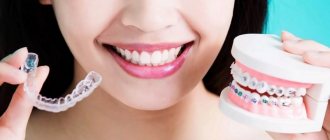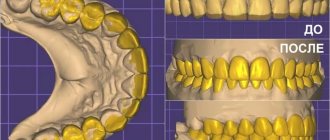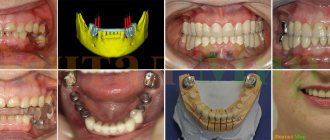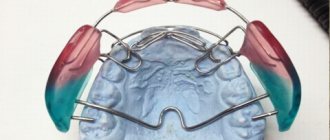Is it possible to do without the retention stage?
For adult patients and adolescents who have had a permanent bite corrected, no. This is a mandatory stage in treatment. Although it is simpler than actively moving teeth, it is no less important. During the movement of teeth, the roots simply do not have time to get used to the new position. There is also muscle memory, and since the roots of the teeth, jaw bone, gums, ligaments are a living and constantly renewed system, then without reinforcement, a reverse movement can immediately begin - regression.
Example: treatment with braces took 2 years, after which the doctor did not install retainers or make mouth guards. The patient himself did not know that this needed to be done. The result was completely lost within 2 weeks.
This situation could have happened 15–20 years ago, when not all clinics worked according to the same standard. Nowadays, every orthodontist will manage the patient taking into account the fact that after treatment a retention stage is needed, regardless of whether aligners or braces were used.
Retainers for permanent wear
The obvious advantage of a lingual retainer is that the patient can forget about the need to use additional structures to consolidate the result of orthodontic treatment. A person very quickly gets used to the wire fixed on the back surface of the teeth and ceases to feel it. It does not interfere with brushing your teeth and does not require special care or medical supervision. The minimum wear period for the splint is 5 years, but it does not need to be removed. Fixed teeth can remain in this position throughout a person’s life without causing discomfort.
Installing the tire requires preliminary preparation. After all elements of the brace system have been removed, the doctor polishes the uneven edges of the teeth, removes bacterial plaque and stone, and fills all carious cavities. And then only the wire is fixed on the incisors and canines. The filling material that holds it in place is carefully polished, making the back surface of the teeth perfectly smooth.
To clean the oral cavity from plaque on a daily basis if you have a permanent retainer, you will have to use special devices. This could be a soft-bristled toothbrush or water flosser. They are necessary in order to thoroughly clean the interdental spaces in the area where the wire is located. About once every 6 months, it is recommended to carry out a professional oral hygiene procedure in order to remove plaque and tartar and saturate the enamel with microelements.
You should not put excessive stress on your teeth: open lids, bite threads, crack nuts. This may cause the retainer to break or become unstuck. If the structure is not repaired in time, the teeth may shift and no longer align.
The cost of making and attaching a permanent retainer is often included in the cost of orthodontic treatment. You can find out the exact price from your doctor.
How does the retention stage proceed?
There are two types of retainers:
- Transparent removable aligners, which are made from dental impressions after treatment.
They are well known to those who wore aligners during active tooth movement. In this case, retainers are the last pair of aligners. Those who have had braces receive these clear aligners for the first time. They are made immediately after the braces are removed. Mouthguards cover all teeth - from the front incisors to the “sevens” or “eights”.
Removable mouth guard
- Fixed retainers.
This is a metal wire that looks like a braces arch, only it is shorter. It is glued to the back of the teeth using a material similar to filling. The retainer is not placed on all teeth, but only on the 6–8 front ones. The arc and the place where it joins are smooth, they do not interfere with diction, are invisible externally, do not affect nutrition and, in general, are not felt in any way.
Fixed retainer
Retention tray after removing braces
A retention guard is designed to maintain the position of teeth throughout the entire jaw after orthodontic treatment. Manufactured using vacuum molding from transparent polycarbonate plastic. To make it, after removing the braces and fixing the retainer, the orthodontist takes impressions from your teeth (as during diagnostics), then a plaster model is cast, and the tray is pressed onto it.
You need to wear a mouthguard every day, or rather, nightly. For at least 1-2 years. After this period, the mouth guard can be tried on, for example, once a week and if pressure is felt on the teeth, wear it for several nights in a row to level out the micro-movements of the teeth.
Often, a mouthguard is made only for the upper jaw. This is necessary in order to give some freedom to the teeth in the lower jaw: over several years they slightly change their position, forming an optimal closure of the teeth.
Retention plate
Retention plastic performs the same function as a mouth guard, but has some features:
- It better maintains the width of the dentition: this makes it the optimal choice if during treatment it was possible to expand the narrow upper jaw.
- Allows micro-movements of teeth in the upper jaw, which increases the adaptive capabilities of the body, in the context of the formation of optimal closure of teeth
- In general, the plate is more structurally reliable; it is also indicated for people with parafunction (improper or excessive functioning) of the masticatory muscles, for example, those suffering from bruxism.
- It is comfortable to wear, but the plastic base of the plate covers the palate, which can create some discomfort, mostly psychological.
- On average, it costs slightly more than a mouthguard, as it is more difficult to manufacture
Both the plate and the mouth guard are effective during the retention period; what to choose is often decided by the orthodontist, based on the clinical situation and personal preferences. The main thing is to adhere to the regime of wearing the devices, in this case you can be calm about the result of the treatment!
How long does this stage last?
Standard – twice as long as the treatment lasted. That is, with treatment for a period of 1 year, the retention stage lasts at least two years. But often, even after this period, it is too early to completely part with the aligners: many patients noted that the teeth may still begin to move. There is a risk of partially or even completely losing the result that was achieved over the whole year.
You can independently determine how great the risk of regression is: do not wear retainers for 1-2 days, and then put them on and listen to your feelings. The aligners were put on with little effort, is there a feeling of pressure on the teeth, especially on those whose position before treatment was more deviated from the norm? This means that microscopic movements of the teeth have already occurred in 1–2 days. It is too early to interrupt the retention stage.
When interrupting the retention stage, it is important not to rush
Relapse after orthodontic treatment
There are several reasons for relapse during orthodontic treatment, and relapse often occurs due to their combination:
- Failure to comply with the orthodontist’s recommendations regarding the timing and regularity of wearing removable retainers
- Failure of a fixed wire retainer without timely correction of the defect.
- Failure to achieve a functional optimum during orthodontic treatment. There are also possible options here:
- Or orthodontic treatment initially implied a compromise result, for example, in the case of orthodontic masking of “surgical” malocclusions, or in the case of leveling crowding in the anterior region, without correcting the closure of teeth in the lateral regions.
- Or, the orthodontic treatment was carried out poorly: for example, in the case of large crowding (lack of space in the jaw), no space was created in the dentition and, as a result of correcting the crowding, all teeth tilted forward, or after orthodontic treatment a large sagittal gap remained (the distance between the upper and lower incisors) and as a result, the upper teeth were not supported by the lower ones and returned to a state close to the original one.
To prevent a relapse from occurring, a responsible and disciplined approach to the retention period is required from both the doctor and the patient. If, nevertheless, it does occur, then it is necessary to consult with an experienced orthodontist: he will offer options for solving the problem (often a partial braces system or aligners) and provide guidance on the cost of re-treatment. After this, you need to weigh the pros and cons and decide whether the game is worth the candle.
How to consolidate the result?
The practice of orthodontists shows that relapses are most often caused by the early removal of retainers or their inconsistent wearing. If you follow all the recommendations of the orthodontist and attend routine examinations in a timely manner, the results of treatment will last for many years and your smile will remain irresistible.
When treating complex anomalies, the doctor may recommend additional observation by an orthopedist, since posture affects the bite and can “pull” it back to an incorrect position, but this is still not an ordinary case.
Caring for removable retainers
Before using trays and plates, the enamel is completely cleaned of plaque and stone. But this does not relieve a person from the need to additionally care for the devices. The trays and plates can be rinsed with water and washed with soap. The use of a toothbrush and toothpaste with abrasive particles is not recommended, as they can scratch the plastic or silicone surface and make it dull. The use of hot water in caring for structures is strictly prohibited, as this can lead to deformation of the product.
It is advisable to use a special container to store the device. Before installing a mouthguard or plate, you need to brush your teeth and rinse your mouth with mouthwash.
What if you have to wear it always?
The option that the orthodontist will advise not to give up retainers altogether is possible. This usually happens in adult patients - it is not always possible to completely correct the posture and position of the joints with braces or aligners alone, so the tendency to regression in the state of occlusion (that is, to move again to the wrong position) may persist.
Even after 3–4 years of the retention stage, regression is possible! Especially in adults.
But this situation is worth looking at from the other side. In dentistry, there are not many types of treatment that give results once and for all.
- Even well-installed fillings sometimes need to be changed. Some people last 20 years, but on average 10 years of service is normal. The same applies to bridges and individual crowns.
- Whitening – the result lasts up to 1 year (if you follow the doctor’s recommendations).
- Professional cleaning requires repetition every 6 months, even if you brush your teeth very carefully at home.
- Veneers, like fillings, last on average 10-12 years, and also tend to fall off.
- Conventionally, implants can be classified as “eternal” types of treatment in dentistry, but there are exceptions - the crowns of implants are also sometimes changed.
And an orthodontist deals not with prostheses or implants, but with living tissue. It is quite natural that if the roots of the teeth have already shifted once due to the peculiarities of their structure, incorrect posture or bad habits, this can happen again.
Moreover, if the patient corrected the bite at 35–40 years old. It turns out that he lived with an incorrect permanent bite for about 25 years, so it is quite expected that after 1-2 years of treatment and the retention stage, the roots will not get used to the new position and will tend to the old place!
This is not an argument against treatment, and all the benefits remain with the patient: a smooth, beautiful smile, easier dental care and maintenance of their health, opportunities for prosthetics or installation of veneers. This only means that the retention stage will probably last indefinitely.
Is it possible to wear a mouthguard constantly at night? Of course, yes - it does not interfere with sleep and does not cause any inconvenience. It needs to be updated once a year or even less often, since the shape of the dentition is already unchanged. And a non-removable retainer does not need to be updated at all, except in cases of partial correction.
If you follow the doctor's recommendations, the achieved result is preserved forever. These recommendations are not at all complicated: patients get used to them and do not notice any restrictions in their lives, but their contribution to dental health is very significant.
Other articles:
Is it possible to correct an overbite at an older age?
How to make your smile perfect? Treatment plus aesthetics
Types of orthodontic systems: from plates to aligners
Retainer
The basis for dental stability after orthodontics is a permanent retainer. It is a metal structure in the form of an arc or stranded wire, which is fixed on the inner surface of the teeth. The retainer material must be both rigid (to securely hold the teeth) and plastic (so that it can be molded to the shape of the dentition for a good fit).
Today, the best option is to install retainers on the six front teeth: from canine to canine (as in the photo below). There is a simplified option with fixation of the retainer only on 4 incisors, but in this case the canines can move to the “before treatment” position. In addition, sometimes premolars are connected to the retainer (especially in the case of the removal of 4 teeth) so that the gap at the site of the extracted tooth does not open. But this option is not universal, since correctly attaching the retainer to the premolars is problematic due to the peculiarities of their shape.
Retainer wearing time
- In the dentition of the upper jaw - 5-10 years , depending on the initial and final position of the teeth: the better the closure of the teeth after orthodontic treatment, the more stable the result. There is an opinion among orthodontists that a retainer on the upper jaw is not necessary, or the period of wearing it can be reduced to 2-3 years. This approach makes sense under the following conditions:
- There was no significant crowding in the anterior maxilla before treatment
- As a result of the treatment, it was possible to achieve good closure of the teeth, both in the anterior and lateral sections, as well as the correct position of the jaws.
- Orthodontic treatment lasted at least 1.5-2 years and the teeth managed to stabilize somewhat in their new position.
- On the dentition of the lower jaw - 10-15 years or more . The incisors on the lower jaw are the most unstable and prone to relapse teeth. In addition, in some cases, with age, they tend to crowd even in people with a correct bite. Therefore, the contracts and IDS of many clinics indicate that the patient must wear a retainer on the lower jaw as long as he wants to be sure of maintaining the results of treatment. To summarize, I will say: the longer the retainer stays on the lower teeth, the better!
What to do if the retainer comes off or breaks?
If the retainer has become unstuck or broken, you can notice this by changes in sensation: part of the retainer may begin to scratch the tongue or the structure of the structure will simply change. In addition, you may hear some crunching noises as you eat.
In this case, you need to make an appointment with an orthodontist immediately. Moreover, if you cannot get to your attending physician, look for another one. This is because teeth, especially the lower incisors, can noticeably change their position in just a few days. The most dangerous time for the retainer to come off is in the first year or two after completion of treatment. If the retainer comes unstuck, the orthodontist will re-fix it on the tooth, and if it is broken, then either an additional segment of the wire retainer will be glued, or it will be completely replaced, depending on the situation.
The retainer only fixes the position of the teeth, therefore, if it changes significantly, it will not be possible to correct the position with its help. To do this, you will have to use additional methods, for example, aligners or a partial braces system are good, but this will result in additional costs.
Removing retainers
The retainer must be completely removed in two cases: if it is broken and a new one needs to be installed, or if the prescribed time of wearing the upper retainer has expired. The procedure itself is not difficult and is carried out quite quickly. The doctor spends most of his time cutting off the remaining composite glue and polishing the inner surface of the teeth.
If caries has formed on one of the teeth and the removal of the retainer is required for adequate filling, then, often, it is only partially removed and fixed in its original position immediately after treatment of the tooth.
